Nearly 18 months after the Myanmar military seized power from the National League for Democracy (NLD)-led government, it has failed to bring the country under its control, resorting to ever more frequent atrocities against the civilian population in the face of an increasingly organized and successful armed uprising against it.
The Irrawaddy editor-in-chief Aung Zaw sat down with Anthony Davis, an analyst for Janes defense publications, to discuss Myanmar’s growing armed resistance, and the strengths and weaknesses of the major players in the conflict—the People’s Defense Force groups (PDFs), the ethnic armed organizations (EAOs) and the military itself.
Aung Zaw: The military has failed to contain the armed resistance, the PDF forces, which only emerged around one year ago. How would you explain this failure?
Anthony Davis: I think one needs to go back to before the coup. It’s clear from everything we’ve seen that the Burmese [Myanmar] military approached this hugely consequential step with a sort of blithe arrogance that they knew what would happen and could handle it. In the weeks before the coup they failed to invest intelligence resources into assessing what the popular reaction to a seizure of power might be and were then caught completely off-guard by what followed. This initial intelligence failure then broadened into a failure to appreciate that suppression of peaceful protests using the military’s old copybook might trigger an explosive reaction. Put simply, they didn’t do their homework and were always behind the curve.
And I might add, not for the first time. Military intelligence failed disastrously to forecast large offensives by ethnic forces in Kokang in February 2015, in north Shan in November 2016 and August 2019, and in Rakhine in January 2019. All this stems from a mix of arrogance, complacency, and remarkable levels of incompetence.
AZ: So, it was an ill-judged coup…
Davis: A catastrophically ill-judged coup which emerged from a deeply rooted institutional arrogance that says, “This is our country, we run this country, we decide what is best for this country. The people will accept it because they always have. We may need to crack the whip but that’s what we do and there’ll be no problem.” So yes, a catastrophe for Min Aung Hlaing and his sit tat [an informal term for the military] which appears to have set Burma on a path towards political revolution.
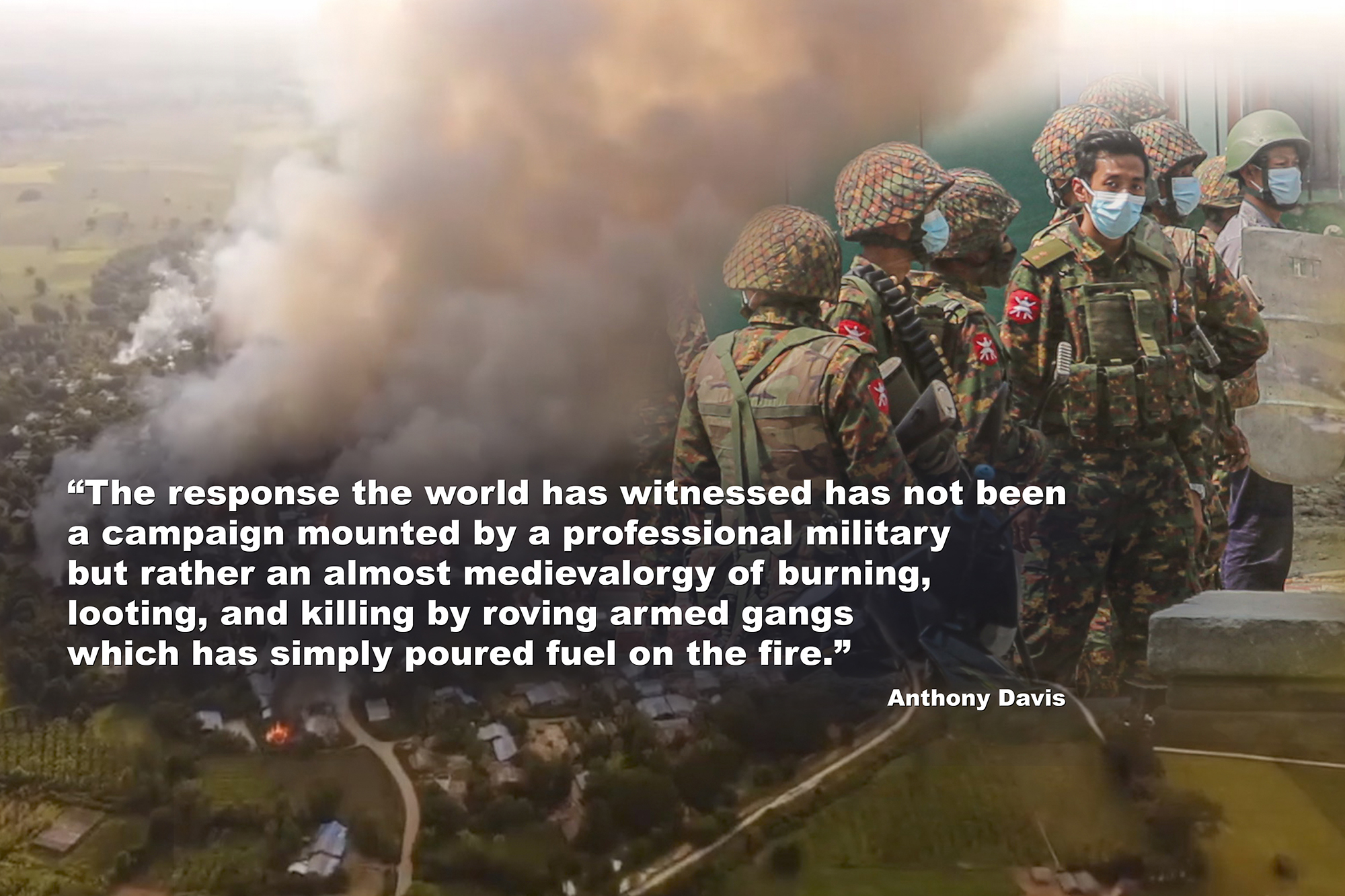
AZ: In just a year, the PDFs seem to have become better organized, better armed and more numerous. No one, including Min Aung Hlaing expected that. You wrote in Asia Times last year that the military would eventually win. But in a more recent article you questioned this. Can you comment?
Anthony Davis: We live and learn! And you’re correct: two weeks after the coup I wrote in mid-February that I thought the military would eventually prevail. That error of judgement stemmed from two misconceptions. First, in the weeks of peaceful protest immediately following the coup I thought the military might have learned both from the negative fall-out of the massacres of 1988, and from the way in which the Thai military handled its coup in 2014. It appeared initially the Burmese military was adopting a more sophisticated approach by exercising patience and restraint in dealing with mass street demonstrations while working rapidly to decapitate the movement by identifying and arresting its leaders. I was wrong: they had learned nothing and by March the knuckle-draggers were back using battlefield weapons against unarmed protesters.
Secondly, I entirely underestimated the anger, determination, and sheer courage of Burma’s youth as a nationwide phenomenon. I was probably not alone in that. I think outside observers—and of course the armed forces themselves—generally failed to appreciate that the younger generation was not prepared to tolerate what their parents and grandparents had put up with and had committed themselves to a revolution aimed at overturning the entire military-controlled order that has prevailed since 1958. The PDF upsurge has stemmed essentially from this sense of a revolutionary turning point in Burma’s history—something which governments in this region and beyond have apparently failed to fully grasp.
AZ: So when did your opinion change?
Davis: My own sense of the situation began to change towards the end of last year. I felt that dry season hostilities in the first half of this year would be the crucial test of whether military repression in Burma’s national heartland could succeed in containing and then crushing piecemeal what was still very embryonic and ill-armed resistance. By the onset of the monsoon season last month, it was clear the military had thrown everything they could at popular resistance, and even in areas that took the brunt of the punishment—Sagaing, northern Magwe, Chin and Kayah—they had not only failed to suppress it; they had actually made it stronger. So the military is floundering in a political and military cul-de-sac with no real way out that I can see.
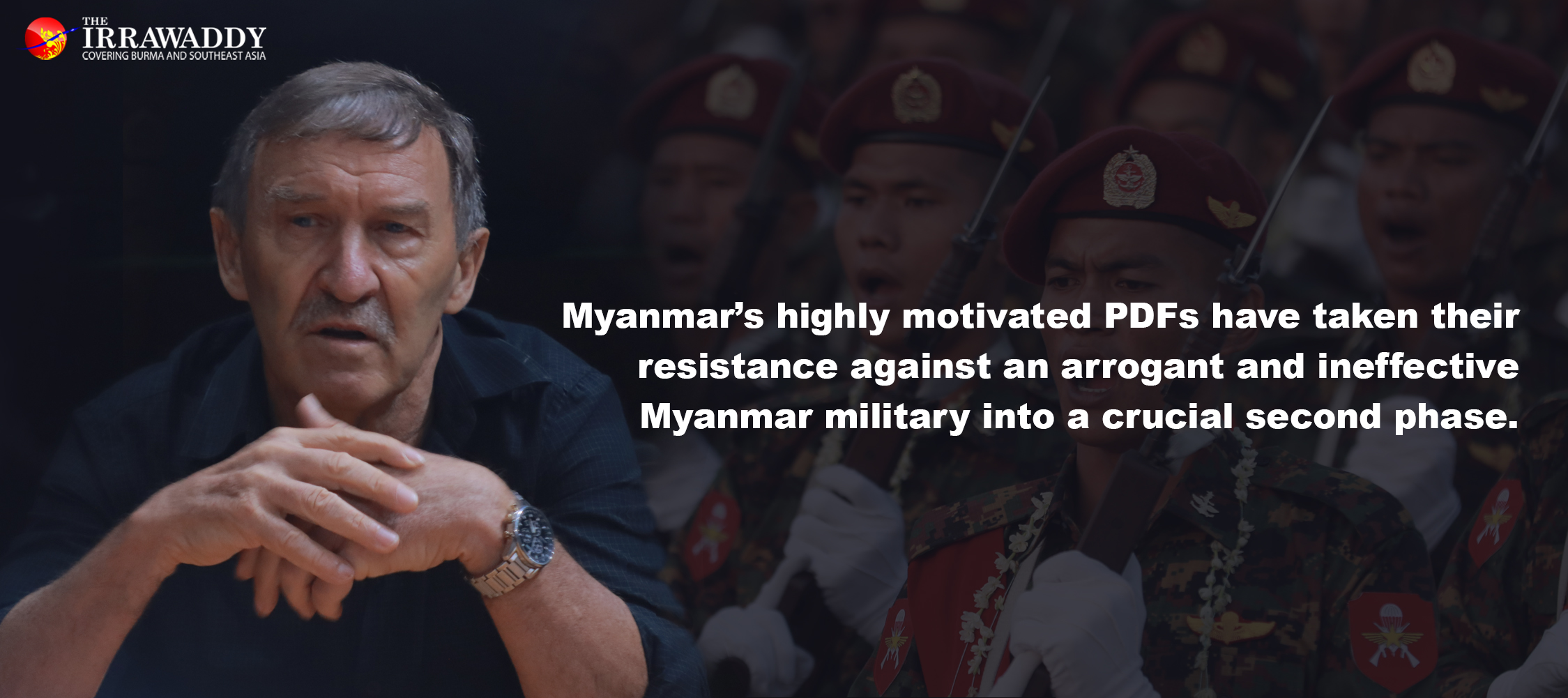
AZ: How did this happen, when they are using trained troops, superior firepower and airstrikes to counter PDFs barely one year old? These are not experienced ethnic armed forces who have been fighting the military regime for decades.
Davis: There are several answers to the question. First, PDFs emerged in very rapid succession across a large number of townships and cities, often with multiple groups in a single township. This would have been a challenge for security forces anywhere, but if we know two things about the Burmese sit tat it’s that even before the coup they were operationally overstretched, and that the level of training in many regional battalions is typically under-par.
Arguably the only formations that are capable of effective, coordinated offensive operations are centrally commanded light infantry divisions or LIDs, and some light infantry battalions or LIBs—the sharp end of the sit tat spear. But what’s interesting is that for most of the post-coup conflict, LIDs have remained deployed in their traditional areas of operations—ethnic minority areas in Shan, Kachin, Karen, Kayah and Rakhine states. Counterinsurgency in the Bamar heartland has been left almost entirely to regionally based police and army battalions backed by militia groups pulled together fast with little or no training.
So, a lack of well-trained troops on one side; and on the other, a proliferation of PDFs which began to outrun the capacity of the military to respond effectively. The response the world has witnessed has not been a campaign mounted by a professional military but rather am almost medieval orgy of burning, looting, and killing by roving armed gangs which has simply poured fuel on the fire.
Finally, I think there has been a tendency to overestimate the effectiveness of air power as a strategic factor in a counterinsurgency. My own experience over quite a few years spent with guerrilla resistance in Afghanistan taught me that air strikes even by well-resourced modern air forces are seldom that effective. They have an initial psychological impact: they can destroy villages and kill civilians at random, but in terms of inflicting serious casualties on guerrilla fighters attuned to the threat they are rarely effective.
What can be extremely effective are rapid airmobile insertions of heliborne troops targeted against guerrilla bases and concentrations. But such operations require good intelligence, operational coordination, well-trained troops, and significant numbers of transport helicopters. The military in Burma is simply unable to bring this mix of capabilities to the fight.
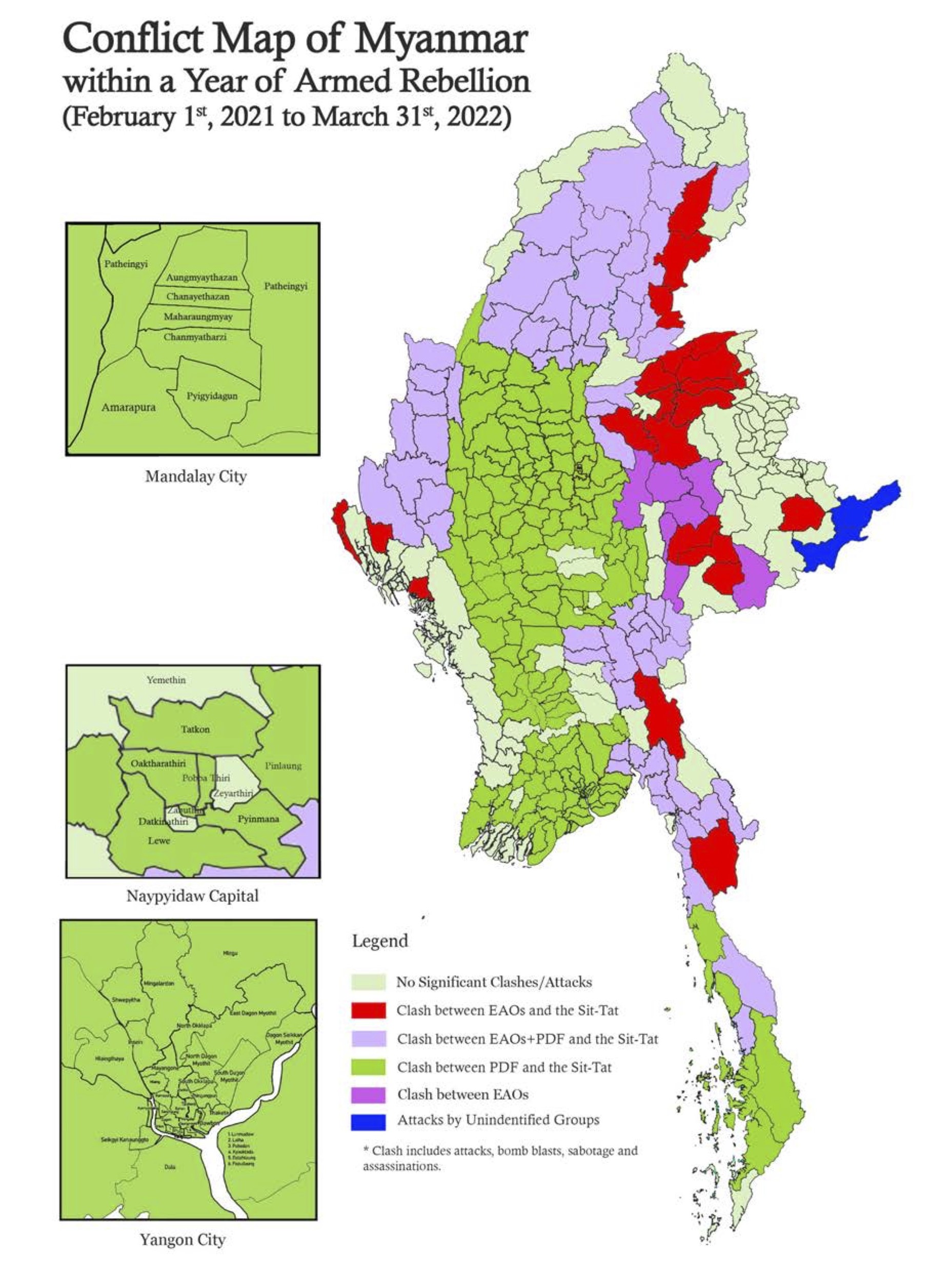
AZ: Having covered several conflicts in South and Southeast Asia, are you surprised by the behavior of the Burmese army or ‘sit-tat’? People are saying we shouldn’t dignify it with the honorific term ‘Tatmadaw’. Once known as a unifying force, people have lost respect for the institution.
Anthony Davis: Well, it’s a measure of their myopia that they still see themselves as a unifying force, but a lot has changed since the period that you are talking about when the military was seen as an effective, even well-respected force. In the period between the 1950s and 1970s when the Burma Army as it was then called reestablished central government control over the national heartland against communist, PVO [People’s Volunteer Organization], and Karen insurgents it was a much smaller organization—well-trained, battle-hardened, and importantly, not corrupt to any degree that impacted its operational effectiveness. It was also viewed as a stabilizing force amid post-colonial chaos.
But what followed the crushing of the democracy movement in 1988 was a decade when the army’s order-of-battle expanded far too rapidly, and the number of battalions mushroomed—even if there were only 200 troops in a battalion rather than a standard complement of 600 or more. So, under-manning became endemic.
At the same time, the 1990s and the first decade of this century were the era of ceasefires with ethnic forces in the borderlands and the bulk of the military was not engaged in combat operations. As a result, training and discipline in most line-battalions suffered while in an increasingly bloated officer corps making money through corruption or private business became very much standard operating procedure.
So the military that went back to war in 2009 following the decision to rein in ethnic ceasefire groups was a very different animal to that which fought during the first three decades after independence. It had grown to become a privileged ruling caste enjoying complete impunity and bogged down in business and associated corruption. Militarily, the navy and air force have been acquiring a range of modern, prestige systems intended to boost Myanmar’s standing in the region. But at the operational level the sit tat is hopelessly unsuited for its primary mission—or rather “mission impossible”—unwinnable counterinsurgencies driven by its own refusal to recognize and accommodate Burma’s ethnic diversity. So, they are out there today with a strategy—for want of a better word—imported from the ethnic borderlands: large-scale population displacement driven by rape, loot, and pillage.
AZ: A related question concerns defections, desertions, and low morale. There is even speculation about the collapse of some units having a snowball effect. Could that happen?
Davis: The answer is yes, but the timeframe is all-important. There’s been speculation about increasing defections pretty much since armed conflict gathered pace in April last year. And certainly, there have been some defections, first from police units in minority areas—Chin and Kayah states—and then in relatively small numbers from the military itself. But it’s important to recognize that the backdrop to this has been a remarkable level of cohesion in the military, which reflects two things: small-unit discipline in a conflict in which the army usually enjoys superior firepower, and the extent to which the military is, socially speaking, a ruling caste largely separated from mainstream society.
That said, cohesion and morale are undoubtedly under real pressure—as reflected in reports over the policing of soldiers’ social media activity. For many soldiers, including officers, there must be a gnawing sense that there is no way back and no clear way forward. So, I believe the coming months will inevitably bring more desertions and defections. But the moment to watch for is when individual defections shift to the unit level—when a section or platoon of troops surrenders or defects with its weapons. When small units start to go over, then you’re looking at a snowball that can gather both speed and size. Until that point, defections are important as a barometer of mood but not yet significant in any strategic sense.
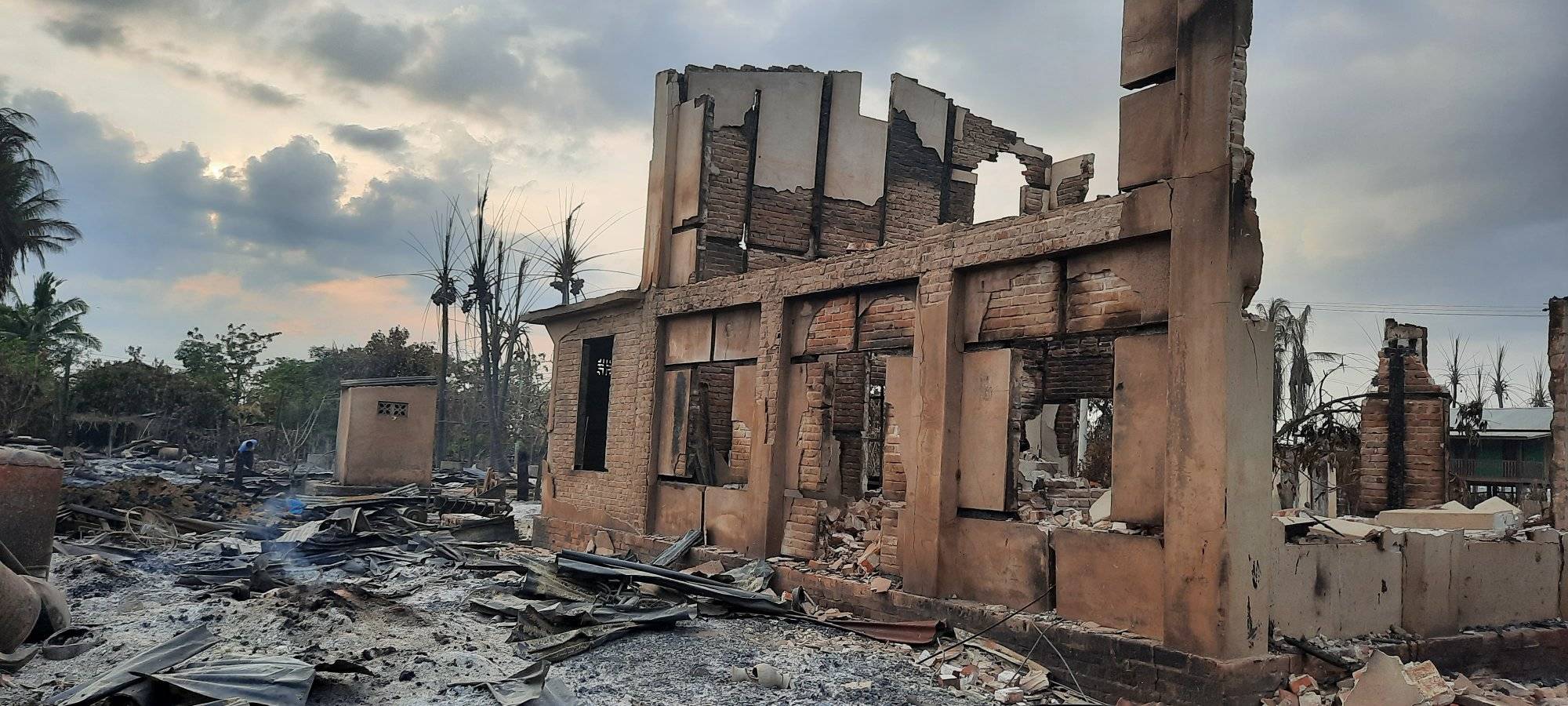
AZ: What about so-called “watermelons”—soldiers who don’t join the opposition or PDFs but remain in the armed forces helping the resistance from the inside? The estimated numbers are surprisingly large. A lot of observers who view the Myanmar military as basically following the ethos of “One Blood, One Command, One Order” find this surprising. How do you interpret it?
Davis: I’d suggest that wishful thinking can lead to overestimating the size of this phenomenon. There are undoubtedly large numbers of military personnel who are unhappy about the way senior commanders have plunged the country into chaos, but who, for various reasons, cannot leave their posts. But are they providing secret information or actively sabotaging the military’s war effort? Almost certainly a few are, but probably not that many: this is a very high-risk undertaking. And the watermelon narrative we are hearing is largely from soldiers who have already defected and have an interest in playing up the level and significance of unhappiness in the ranks. So, I would caution against overestimating the size or the potential impact of this phenomenon at least in the short term.
AZ: How do you read what is being called the “second phase” of PDF armed resistance? Groups that started with hunting guns and tumi-rifles a year ago have acquired assault rifles, RPGs, 60mm and 80mm mortars and even drones.
Davis: There’s no question this conflict is in its second phase and the speed with which this shift has taken place over the past dry season has been striking. Last year rural PDFs started with raw anger and hunting rifles and today there are engagements lasting hours and involving scores, even hundreds of fighters, some armed with automatic rifles and support weaponry seized from the enemy, acquired from sympathetic ethnic resistance organizations, or manufactured by some remarkably innovative PDFs. So yes, this is obviously a new level, a second and very different phase.
That said, I think it would be dangerous for people to let this go to their heads. What I suggested in a recent article was that if you are looking at this in terms of rural-based guerilla conflict, successful practice typically involves three rather than two distinct phases. And the second phase does not mean the resistance is anywhere near victory; it simply means it has achieved a secure foundation on which to build: upgrade weaponry, form larger, better organized units, and begin setting up parallel government structures and services in resistance-dominated areas.
Militarily, what is crucial at the beginning of Phase Two is training a cadre of junior officers capable of commanding platoons and companies. And, at the same time, taking village-based PDFs that emerged in Phase One as a foundation for building full-time, semi-regular companies and battalions which are reasonably well armed and can conduct mobile warfare. That means moving rapidly in coordinated operations between different townships and eventually regions, and gradually forcing the enemy into defending urban areas and lines of communication.
Depending on all sorts of other variables, domestic and international, it could take two, even three years for a guerrilla force to build from zero a capacity for semi-regular mobile warfare. That could then lead to a third period of strategic offensive when revolutionary forces sever main communications arteries, bring airports under pressure, and cut off major cities from each other.
But it would be a serious and potentially costly mistake to imagine that because PDFs have rocket-launchers and machine guns they are ready to capture even small towns from an enemy that still possesses significant firepower. One needs to know how to walk properly before trying to run.
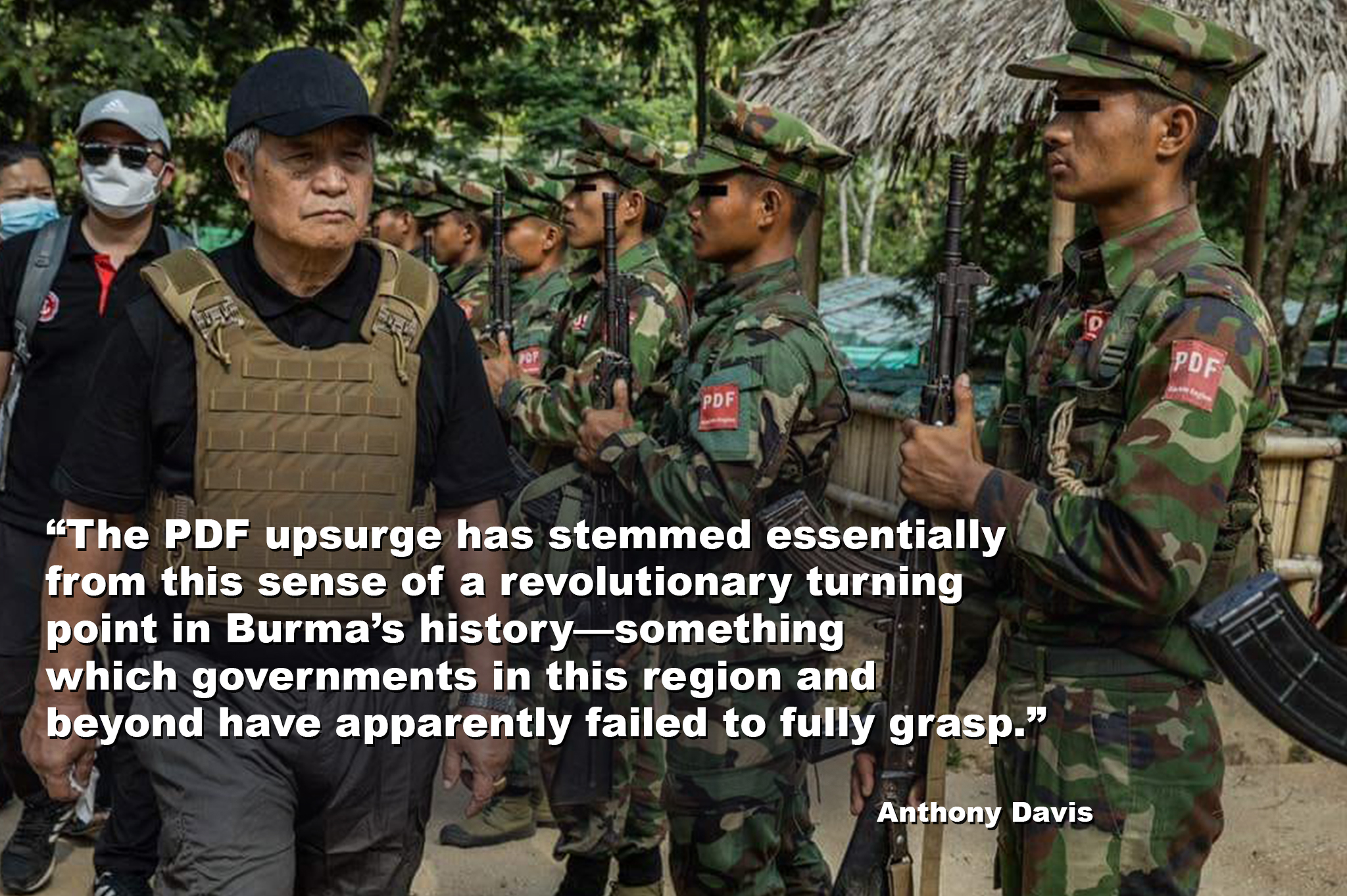
AZ: The armed resistance started in Sagaing and has since forged links to the Kachin Independence Army (KIA) to the north and other EAOs. The resilience of villagers becoming PDF fighters and sustaining resistance has been remarkable. Can you share your interpretation of Sagaing Region and this “northwestern corridor”?
Davis: I am certainly not an expert on conflict dynamics in Sagaing. But my informed guess would be that several factors are probably in play. One, the region has been a very solid base of support for the [National League for Democracy (NLD)] and the treatment meted out to “Mother Suu” [NLD leader and detained State Counselor Daw Aung San Suu Kyi] almost certainly stirred a lot of anger at the community level.
Secondly, as you’re suggesting, in the 2014-2018 period Sagaing played a crucial role as a logistical link zone between the KIA in Kachin State and the growth of Arakan Army power in Rakhine State. This doubtless established networks and supply channels that more recently have been able to support some PDFs in Sagaing itself.
In 2018 during the lead-up to the Arakan Army offensive of January 2019 I was amazed to be able to drive around the Sagaing region on a motorbike for days without coming across a single police or army traffic control checkpoint. The security forces were asleep at the wheel—exactly as in Kokang in early 2015 and northern Shan in late 2016.
And that leads directly to a third factor: a higher than usual level of military incompetence in dealing with the beginning of popular resistance activity in the region. The sacking of the Northwestern Military Region commander Phyo Thant in late 2021 appeared to confirm that.
All these things bring us back to a factor I noted earlier: repeated failures of intelligence on the part of a military that has always tended to see brute force as the best way to solve problems. It is instructive to compare the Sagaing experience with the careful investigations and preparations carried out by the Royal Thai Army’s Internal Security Operations Command in politically sensitive communities of north and northeast Thailand for months, even years before the coup of May 2014. There you saw a military using its brains precisely to avoid having to resort to force.
AZ: There has been collaboration between EAOs and PDFs, both those affiliated with the National Unity Government and those that are not. Though this collaboration is disjointed, I think the role of EAOs is highly regarded by Myanmar people. Without them it would have been impossible for PDFs to sustain operations this long. What’s your reading of the EAOs and their collaboration with PDFs?
Davis: You’re right: collaboration has obviously been critical. The level of PDF resistance that was apparent by mid to late 2021 could simply not have happened without the training, logistical support, and in some cases combat support provided by the KIA, the KNPP [Karenni National Progressive Party], the KNLA [Karen National Liberation Army], and CNA [Chin National Army].
Looked at from a historical viewpoint, successful guerrilla struggles have typically required support from an external power. It’s almost impossible for a guerrilla movement to survive and expand without external support. In today’s struggle in Burma external support was clearly not going to come from Thailand, India or China, neighboring countries invested in the success of the Burmese military and—please don’t laugh—its central, unifying role. From Day One that threatened PDFs with the prospect of being slowly crushed—not overnight but, as with guerrilla forces in central Burma in the 1950s, over two or three years. However, the requirement for external support has to a crucial degree being picked up by EAOs. Without it, we would not be looking at the situation we are looking at today. That’s clear.
What is also clear is that the country’s ethnic minorities will demand and will deserve an entirely new and more equal role in Burma’s future governance. They are not making these sacrifices out of the goodness of their hearts.
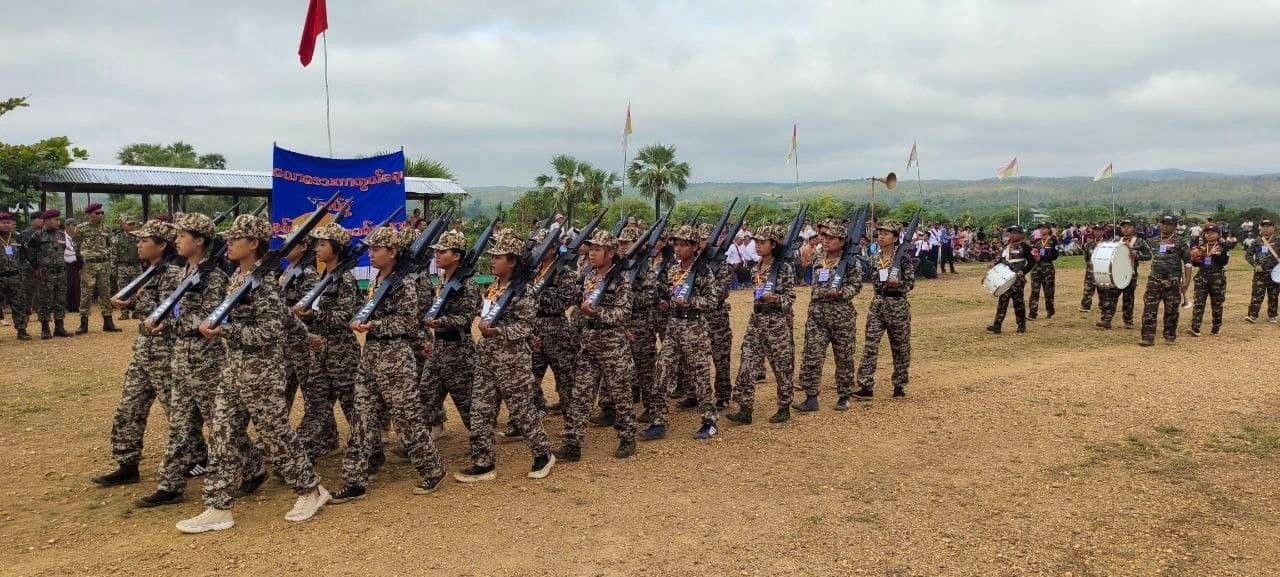
AZ: The military was smart in establishing a stable ceasefire with the Arakan Army (AA) in the months before the coup. But that ceasefire is today anything but stable: there could be a return to war anytime, a situation that is tying down a lot of sit tat forces. In your opinion what would happen in the event of renewed war in Rakhine State? Can the regime risk such a fight?
Davis: The simple answer is that any return to the level of hostilities seen in 2019 and 2020, when elements of six out of a total of 10 LIDs along with Western Command forces were operating against the AA, would create a massive problem for the regime in terms of logistics and manpower. But the regime cannot afford to lose Rakhine any more than it already has. So a return to full-scale conflict would demand a dramatic reinforcement by LID elements and other forces currently committed elsewhere—probably from Bago Region and Shan State where the situation is relatively—but only relatively—stable.
That said, I doubt there will be a return to full-scale war during the rainy season, which would tax resources on both sides. But the AA certainly has an interest in chipping away at the regime’s hold on the state and the Bangladesh border is an area of real vulnerability for Naypyitaw. It is no coincidence that in recent weeks there has already been a significant reinforcement of troops and heavy artillery into northern Rakhine—Rathedaung, Buthidaung and Maungdaw—which presumably reflects regime concern over losing control of the border. So, this is all fairly desperate stuff—juggling responses to multiple escalating threats with inadequate, even shrinking manpower.
AZ: Naypyitaw cannot afford to lose Shan State either. You wrote an article in February examining the advances of the United Wa State Army and its allies and the defeat of the Restoration Council of Shan State. We all know who is behind the Wa and the importance of the China-Myanmar Economic Corridor (CMEC) in Shan State. What do you see as likely scenarios?
Davis: Obviously we need to look at China’s concerns over chaos in central Burma and the importance of Shan State as the first leg of CMEC—border economic cooperation zones at Chin Shwe Haw and Muse, the railway to Mandalay, and then possible plans to begin building dams on the Salween River. Put simply, the successes of the UWSA and its Shan and Ta’ang ethnic allies since the coup have essentially secured China’s CMEC interests in Shan State. The RCSS has been driven out of the north and center of the state and will not be coming back. So, Beijing has covered its bases, if you like. China will not be taken by surprise in northeast Burma.
There is an obvious question over the survivability of Naypyitaw’s Border Guard Force in Kokang and the possible return of the MNDAA [Myanmar National Democratic Alliance Army] to control that region. But more broadly, I think the situation in Shan State will probably remain stable until the trajectory of the conflict in central Burma becomes clearer. If in one or two years’ time that conflict were to reach a tipping point—maybe as a result of renewed war in Rakhine, maybe not—the strategic situation in Shan State could shift very quickly from precarious to critical. It is not fanciful to envisage the UWSA moving to link up their northern and southern regions and unilaterally declaring a new “Wa State”—in full control east of the Salween and dominant west of the river. At that point Naypyitaw effectively loses Shan State: game over.
AZ: So should Thailand be worrying about its security?
Davis: Absolutely. Starting yesterday. Consolidation of Wa dominance across Shan State means Thailand would be facing a powerful, pro-Chinese narco-state controlling its entire northern border. In terms of transnational crime, money laundering, and threats to the integrity of Thailand’s banking system and politics, and the smuggling of drugs, guns, people—you name it—this would mark a dramatic deterioration of national security.
The authorities are obviously watching the situation carefully, but as we’ve seen over the past year, Thai policy has rested largely on the hope that the Burmese generals can hold it all together. And you know the saying: hope is not a strategy, especially when it’s increasingly obvious that the Naypyitaw regime cannot hold it all together and in fact is in very deep trouble.
AZ: My final question: Has China won Shan State?
Davis: It’s a complex region and the game is still in play. But I think we can agree that in Shan State it’s getting close to check-mate.
Anthony Davis is a regional security analyst and consultant for the Janes defense publishing group.
You may also like these stories:
Myanmar Junta Airstrikes Continue in Kayah State
Hell Hounds Are Loose in Myanmar; Who Can Stop Them?
Myanmar’s Min Aung Hlaing, Russia’s Putin and Their Ilk Must Not Prevail
Myanmar in Revolt as People Choose to Fight the Brutal Regime

















